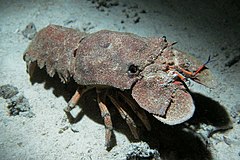Scyllarides latus
| Scyllarides latus | |
|---|---|
 |
|
| Scientific classification | |
| Kingdom: | Animalia |
| Phylum: | Arthropoda |
| Subphylum: | Crustacea |
| Class: | Malacostraca |
| Order: | Decapoda |
| Infraorder: | Achelata |
| Family: | Scyllaridae |
| Genus: | Scyllarides |
| Species: | S. latus |
| Binomial name | |
|
Scyllarides latus (Latreille, 1802) |
|
| Synonyms | |
|
|
| External identifiers for Scyllarides latus | |
|---|---|
| Encyclopedia of Life | 343717 |
| ITIS | 97680 |
| NCBI | 204053 |
| WoRMS | 107708 |
Scyllarides latus, the Mediterranean slipper lobster, is a species of slipper lobster found in the Mediterranean Sea and in the eastern Atlantic Ocean. It is edible and highly regarded as food, but is now rare over much of its range due to overfishing. Adults may grow to 1 foot (30 cm) long, are camouflaged, and have no claws. They are nocturnal, emerging from caves and other shelters during the night to feed on molluscs. As well as being eaten by humans, S. latus is also preyed upon by a variety of bony fish. Its closest relative is S. herklotsii, which occurs off the Atlantic coast of West Africa; other species of Scyllarides occur in the western Atlantic Ocean and the Indo-Pacific. The larvae and young animals are largely unknown.
Scyllarus latus is found along most of the coast of the Mediterranean Sea (one exception being the northern Adriatic Sea), and in parts of the eastern Atlantic Ocean from near Lisbon in Portugal south to Senegal, including the islands of Madeira, the Azores, the Selvagens Islands and the Cape Verde Islands. In Senegal, it occurs together with a related species Scyllarides herklotsii, which it closely resembles.
S. latus can grow to a total body length about 45 centimetres (18 in), although rarely more than 30 cm (12 in). This is equivalent to a carapace length of up to 12 cm (4.7 in). An individual may weigh as much as 1.5 kilograms (3.3 lb). As in all slipper lobsters, the second pair of antennae are enlarged and flattened into "shovels" or "flippers". Despite the name "lobster", slipper lobsters such as Scyllarides latus have no claws, and nor do they have the protective spines of spiny lobsters. Instead, the exoskeleton, and particularly the carapace, are thicker than in clawed lobsters and spiny lobsters, acting as resilient armour. Adults are cryptically coloured, and the carapace is covered in conspicuous, high tubercles.
...
Wikipedia

